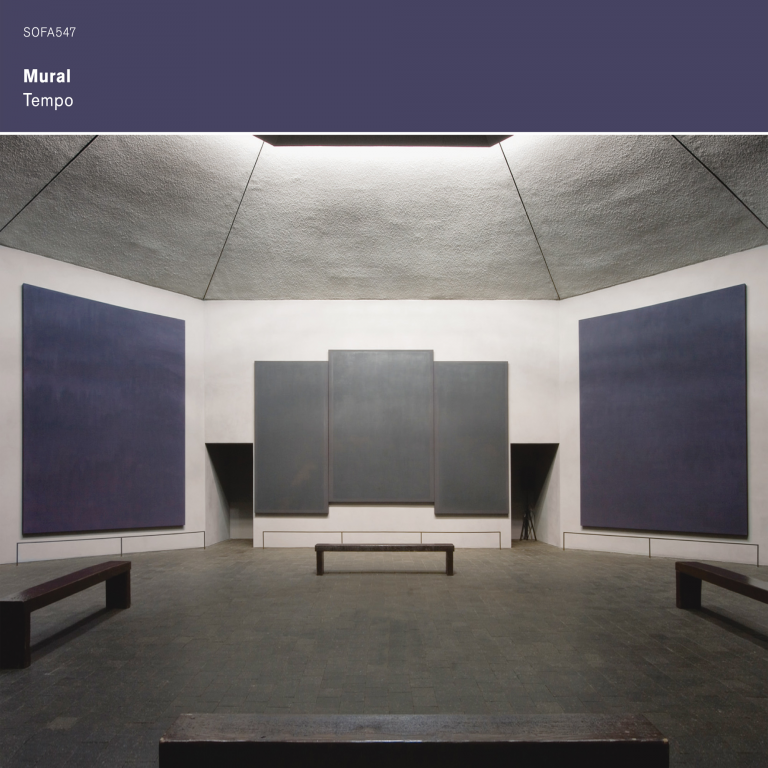Mural are making Houston’s Rothko Chapel a regular home from home. The trio—Australian Jim Denley (wind instruments) and Norwegians Kim Myhr (guitar) and Ingar Zach (percussion)—had played two previous concerts there before the site-specific event that’s now documented on Tempo (the second yielded Mural’s 2011 album Live at the Rothko Chapel, which is available via rothkochapel.org).
Tempo (SOFA) was recorded in 2013, during a performance that lasted a full four hours. The album presents three long, uncut excerpts from the second, third and fourth hours, plus a 20 minute coda, on three CDs.
Given that the Chapel functions as a place of contemplation or non-denominational worship, the music isn’t as meditative as you might expect. The sound of the elements is occasionally audible as background noise, and what was evidently an overcast and windy day can only have enhanced the muted ambience of Rothko’s achromatic murals. So the atmosphere was pre-loaded, the sonic canvas already primed when the performance began.
The audience were free to enter, occupy the space and leave at will, so the performers could focus on the moment, yet there’s clearly a collective developmental logic at work here. Each of the three CDs works just fine in isolation, but the full set is engaging enough to make it tempting to stick around for the duration.
On the second disc (“Third Hour”), for example, the prevailing mood after eight minutes (established by gently strummed guitar, subtle spasms of gran casa or low-pitch bass drum, and breathy flute) is reprised a full fifteen minutes later. In the interim, thrumming tintinnabulation creates a brightness that slowly leeches away, to be supplanted by dolorous gong strikes and probing foghorn sax.
Second Hour (disc one) explores gradually expansive drones and close textures (metallic scrapings, contact buzz, and plosive pops), quite quickly gaining in textural richness. There’s a heartbeat bass drum pulse, with gentle ripples of guitar accompaniment, but also more disruptive percussion and coarser saxophonics. 33 minutes in, clearer tones of bowed glass or cymbals, zither glisses and purring sax combine in an introduction to a gorgeous section that’s characterised by electronic-sounding chimes, presumably sourced from small brass bells or finger cymbals though the sound is reminiscent of Oval’s minimal glitch electronica piece “Do While”.
Percussionist Ingar Zach—best known for his work with Huntsville—combines beautifully with Jim Denley on “Third Hour”. Witness, about half an hour in, his swirls of brushed and rubbed gran casa skins melding with a burred saxophone sustain and circular breathing that amplifies Denley’s breath into a wind machine.
Press notes highlight Denley’s interest in exploring the saxophone’s “relevance to ancient and current traditions in Australian music”, as well as “innovative electronics and miking”. Straightforwardly tuneful playing is mostly held in reserve, in favour of soundings deep in the grain of the music’s texture. “Third Hour” begins with solo sax in short but keenly incised phrases, variations in embouchure testing the ply of the Chapel’s loaded ambience.
As for Kim Myhr, there’s no sign here of his musics for dance, nor for jazz orchestra, but there is plenty of evidence for his interests in American folk music and composers György Ligeti and Morton Feldman (another composer of music for the Rothko Chapel). Myhr ends the ambient intro to “Fourth Hour” (disc three, track one) with feather-light 12-string picks, the guitar sounding out cleanly at first, then enriched with bowl chimes and footsteps (the only noticeable audience intrusion on the whole set). Denly’s sax enters as mere breath sounds, but subtly fills out as Myhr’s guitar suggests a melody. Then sub-bass reverb from gong strikes turn the mood ominous, merging with Myhr’s now thrumming guitar into a deep drone.
This last movement of the main set features some of the album’s most dynamically eventful music. At 19:45 there’s only sax, plaintive but non-vocal, blending with high-pitch cymbal or Tibetan bowl scrapes, but then ringing like a twin bell alarm clock turns the atmosphere edgily static. At 26:00 it sounds like elementally raw weather has invaded the chapel. Brief irruptions of gran casa break the spell, and Denley’s sax probes percussive echoes while rain provides a backwash for delicate glints of zither and 12 string. Guitar picking then provides a holding fix for abstract sax, airy fluting and percussion improvisations. At this stage, everything is airy and delicate, even, perhaps, subtly playful.
The muted conclusion to the main set comes with a few minutes of pure ambience, then a crescendo of small sounds that end in sax licks that curl smokily into plumes suspended in silence. The 21 minute “Coda” that ends disc three flows naturally from there, beginning with harp-like zither and vocal percussion plus pianistic percussion trills and birdlike fluting. A marble or ball-bearing rolls and settles. A brief flurry of agitation yields a brief, rhythmic guitar figure and extended flurries of saxophonic contact sounds and circular breathing, taken down by zither glissandoes and lulling guitar.

